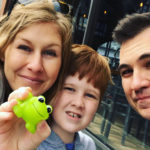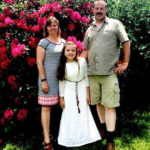Generations of excellence in surgical care: Dr. Emans and Dr. Hogue

Some surgeons follow their patients for years, even decades. This is true of Dr. John Emans, who has treated patients with complex spine conditions at Boston Children’s Hospital for more than 40 years. Beloved by patients, he is also widely respected by spine surgeons for his groundbreaking scoliosis research.
Dr. Grant Hogue first met Dr. Emans in 2012 when he was an up-and-coming orthopedic surgeon. After a year of additional training in pediatric orthopedic surgery at Boston Children’s, Dr. Hogue moved to the University of Texas. He became division chief of orthopedics and an endowed chair, the highest academic award a university can bestow on a faculty member. But he stayed in touch with Dr. Emans, collaborating on difficult cases by phone and email.
Years passed and Boston Children’s Spine Division needed to increase its staff. After a national search, Boston Children’s hired Dr. Hogue. Since Dr. Hogue’s arrival this spring, the two surgeons have co-managed Dr. Emans’ surgical patients.
Below, Drs. Emans and Hogue talk about why they each chose to practice at Boston Children’s, how patients with complex conditions keep them on their toes, and what they look forward to in the coming year.
Why would a spine surgeon with a thriving practice relocate to Boston?
Dr. Hogue: I had a good situation in Texas. I was a division chief in the hospital and an endowed chair at the medical school. Very few things could have pulled me away from that — just Boston Children’s. The complex patients who seek treatment here stretch me to become a better surgeon every single day. In most other places, any one of these patients would be the most complex case you’d see that year, maybe that decade.
Dr. Emans: Boston Children’s is an amazing place with incredible depth of practice. If you look at the surgeons here, so many of them have a similar story. They chose to practice here rather than be chief someplace else because of our rich practice environment.
In addition to treating patients, you both also train young surgeons. How do you approach teaching?
Dr. Emans: It’s almost impossible to teach a surgeon everything they need to know, other than through practical experience. Our fellows (accredited surgeons who come to Boston Children’s for an additional year of training) learn the most from our complex patients. We all learn from them. The fellows see us making clinical decisions on cases where there are no clear answers. I think the teaching model is really a matter of ‘let’s think this through together.’
“The complex patients who seek treatment here stretch me to become a better surgeon every single day.”
– Dr. Grant Hogue
Dr. Hogue: From a learning perspective, I would add that the best thing a fellow can hope for is to see two surgeons disagree about something, and then present their reasons. Surgeons here do that all the time, debate in a civil way. Everyone understands that it’s not a red mark against you as a surgeon if someone asks you to explain your decisions. We’re all learning together.
Do any spine patients stand out in your memories of Dr. Hogue’s fellowship year?
Dr. Hogue: There was one young patient with a hemivertebrae (half-formed vertebrae). We did a short fusion in his lumbar spine and stabilized his ribcage with rods. It looked like we were building a field goal inside his chest. It was unlike anything I’d seen or done before.
Dr. Emans: That case created a lot of controversy, but it turned out well for the patient. His case now appears in a couple of textbook chapters and others have followed the technique. That’s the sort of case that makes practicing here so rewarding.
Treating the most complex patients, as we all do at Boston Children’s, is just continually fascinating. When you see something you haven’t seen before, you can’t say, ‘I don’t know what to do, why don’t I refer this to another surgeon?’ Surgeons refer rare or difficult cases to Boston Children’s. If you understand your patient’s complex anatomy and you understand biomechanical principles, you can often figure out a way forward. That’s what we do here.
Why was the Spine Division looking for a new spine surgeon?
Dr. Emans: Grant’s position was opened partly because some of us are approaching retirement age, and partly because one member of our group moved on to lead another institution. It was time to bring in a new generation of surgeons to care for our patients.
How did you choose Dr. Hogue to follow in your footsteps?
Dr. Emans: We wanted someone who would move the research and academics forward and also inspire confidence in patients. You can have amazing qualifications, but you also have to be a positive presence for patients. Grant’s personality puts patients and families at ease. He listens to them and helps them feel like they are in good hands. And of course, he has remarkable surgical skills and a genuine interest in learning from his patients and colleagues.
How has it been to practice together?
Dr. Hogue: I’ve had opportunities to co-manage cases with many different surgeons in my career. I think for most of us, having two surgeons in the room is nerve wracking. We are all used to being the leader of our operating room. But Dr. Emans and I operate very well with each other. I’m obviously very open to trying things his way. And he’s open to trying some of the new things I started doing since I was a fellow here.
“You can have amazing qualifications, but you also have to be a positive presence for patients.”
– Dr. John Emans
Dr. Emans: I’ve been staying out of the hospital during the pandemic except to operate. Grant and I have done all of our operations together and Grant follows up with patients who need to be seen in person. I’ve learned a lot from him in the operating room. It has been a learning experience for both of us.
What are you looking forward to in the years ahead?
Dr. Emans: I look forward to continuing to co-manage patients with Grant. I think that COVID-19 has been interesting in that it has exposed him to a lot of my patients quickly. But I’d certainly like to get back to actually seeing patients in person.
Dr. Hogue: Dr.Emans and I share an office. I look forward to him returning to the office so we can collaborate in person.
Dr. Emans: I’m delighted that Grant has joined our team. A couple of years ago, I was nervous about what would happen with my patients when I retired. I am no longer nervous.
Learn more about the Spine Division and the Complex Cervical Spine Program.
Related Posts :
-

Born with congenital scoliosis, Thelma looks to the future
Sixteen-year-old Thelma Alemnji probably enjoys student life more than most high school juniors. After all, up until last year, activities ...
-

How Josie’s bad day turned into a campaign to help kids with scoliosis
Josephine DeFilippi (Josie) describes the day of her scoliosis diagnosis as the hardest day of her life. Right when she ...
-

Provider Spotlight: Meet Dr. Grant Hogue
Dr. Grant Hogue completed his fellowship in orthopedic surgery at Boston Children’s Hospital in 2015. He spent the next five ...
-

Congenital scoliosis: Maria’s story
Growing up in a big family helped. When Maria Dupuis came home from the hospital after surgery to correct her ...





